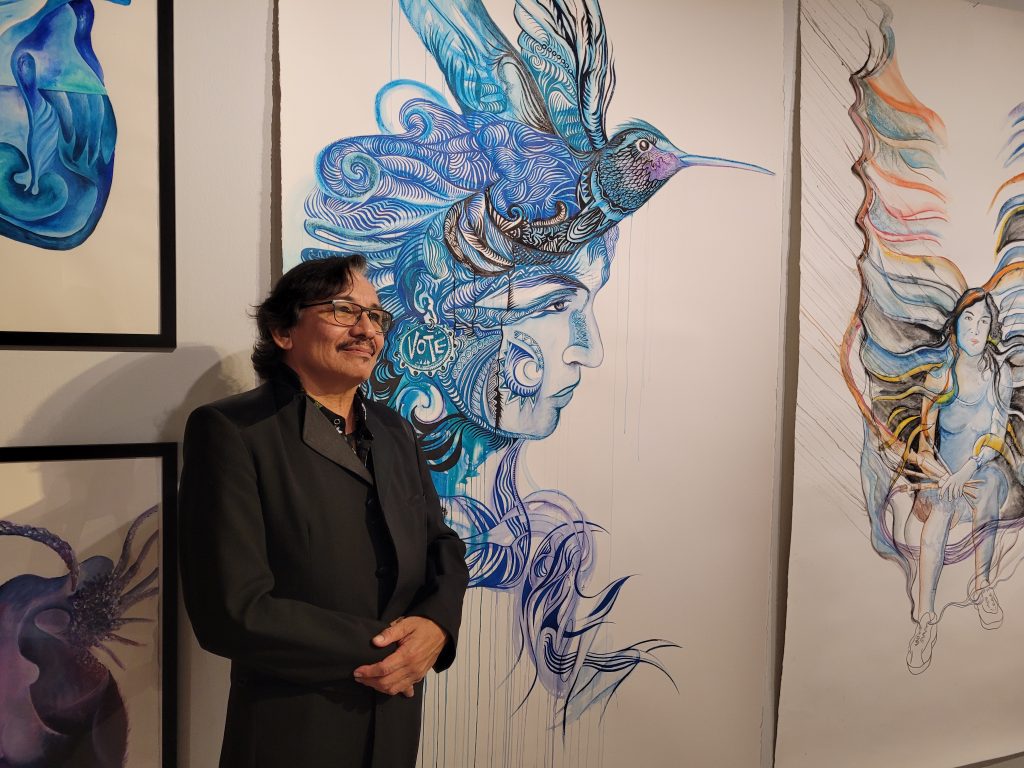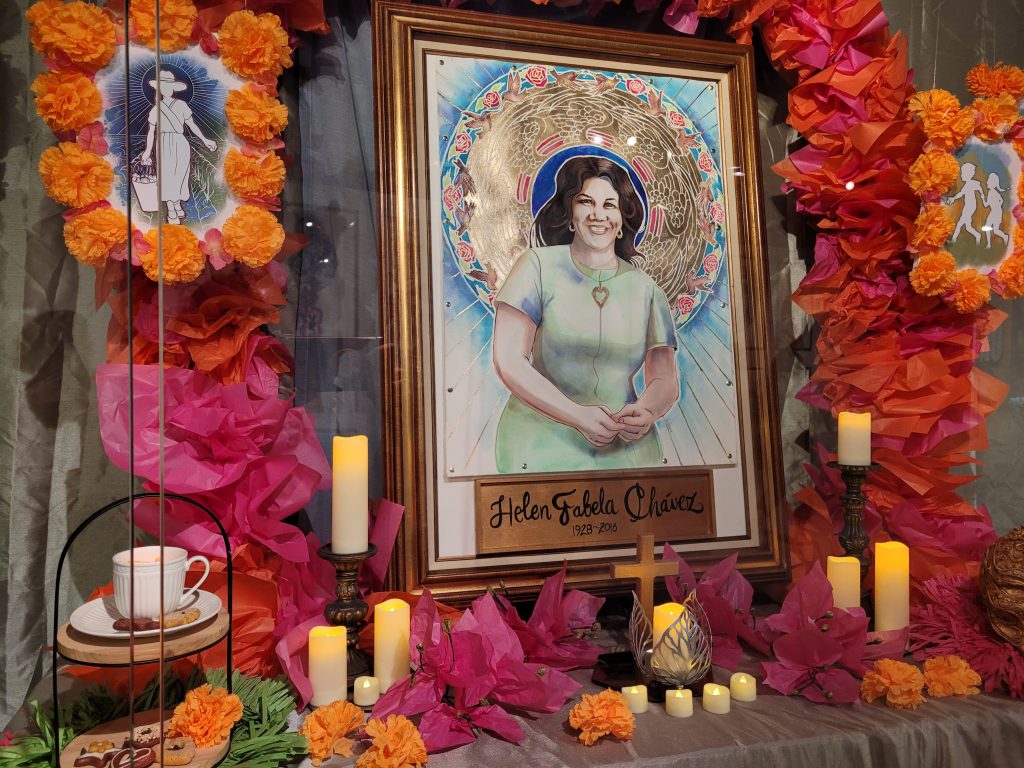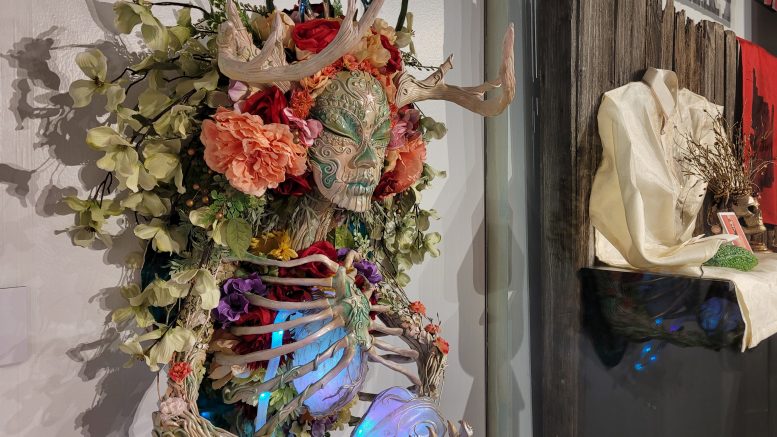By Justine Chahal
The California Museum hosted its 11th annual Día de los Muertos Fiesta on Saturday, Oct. 12 to unveil its new exhibit “Arte de Inspiración: Día de los Muertos 2024.”
The fiesta featured vendors selling wares ranging from sculptures to art prints. There were also a variety of performances, including a ceremony led by the Maquilli Tonatiuh Aztec Dancers who attend each year.
The exhibit, which is located on the museum’s second floor, showcases work from California artists who were each asked to create an altar dedicated to an important Californian figure, said California Museum Executive Director Amanda Meeker. She added that there’s always an interest in activism when it comes to what figures the artists choose.
John Hancock and Juan Ramos, an artist duo and married couple, dedicated their altar to Larry Itliong in order to raise awareness of Itliong’s contributions to the United Farm Workers (UFW), Ramos said.
“I was familiar with who he was and I always felt he never got his rightful place in California farm labor history,” Ramos said. “This was meant to correct the history. It’s not to downplay what Cesar [Chavez] and Dolores [Huerta] did but he was always just kind of in the background.”
Hancock said the altar displays real tools utilized by UFW members, including a shovel and handmade flag used during a march. These items are paired with paintings of Itliong and watercolor portraits rendered by Ramos.

Hancock said he loved the idea of honoring their ancestors through the event and hopes the altar can educate people on the UFW as well.
“Folks like Larry Itliong who didn’t get the acknowledgement that they deserved when they were alive — at least they’re getting it now,” Hancock said. “I’m happy that we can hopefully educate some people to make them realize little things, like how these farm workers had to work and what they endured back then. “
Artist Kriztianna also dedicated her altar to an important UFW figure; Helen Fabela Chávez. Kriztianna said she wanted to celebrate Chávez’s work by painting her portrait surrounded by symbols that represented important contributions she had made, including working at the Farm Workers Credit Union.
She also found it important to represent the work of women during strikes.
“I wanted to make sure that I showed how much women are contributing to the physical labor of farm work because so often I see men represented, which is super important, but this altar was in memory of Helen and also the invisible labor of women in these movements,” Kriztianna said.

Adrian Arias, who has been making art for over 40 years, created two separate altars for Chicano artists René Yañez and Yolanda López, who he knew when they were alive. His altar to Yañez displays his portrait alongside personal belongings including notebooks and brushes, while the one dedicated to López takes inspiration from her Guadalupe series, said Arias.
Arias said López urged him to not be afraid of his imagination. He painted his altar pieces on paper with rough edges because it felt like the most organic medium to express his feelings, he said.
“Talking about Yolanda and René, they were my mentors,” Arias said. “Incredible Chicano artists, very influential to the community. Using paper is good, like putting back stories … For me and for California artists, they are this kind of influence. We have them all around.”
Visitors can also honor their own lost ones at the museum’s community altar, Meeker said.
“That’s sort of the central piece of this whole celebration is remembering our loved ones and the altar being a key part of that celebration traditionally, so we wanted to bring that here,” Meeker said. “The artists create altars but we wanted our community to bring remembrances of their own loved ones and just make it part of the celebration of people that we love and have lost.”

Meeker said with the holiday’s rising popularity, she wants visitors to be able to learn more about its traditions and these Californian figures. Kriztianna, who did not know much about Chávez prior to doing research for her altar, said she hopes for the same.
“I would love for people to just go and learn about the other altars and kind of feel the importance of remembering those who have passed and the work they did and try to continue it,” Kriztianna said.
This story was funded by the City of Sacramento’s Arts and Creative Economy Journalism Grant to Solving Sacramento. Following our journalism code of ethics and protocols, the city had no editorial influence over this story and no city official reviewed this story before it was published. Our partners include California Groundbreakers, Capital Public Radio, Outword, Russian America Media, Sacramento Business Journal, Sacramento News & Review, Sacramento Observer and Univision 19. Sign up for our “Sac Art Pulse” newsletter here.


Be the first to comment on "Annual Día de los Muertos Fiesta, or ‘Day of the Dead,’ honors important figures with art"